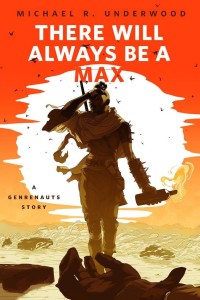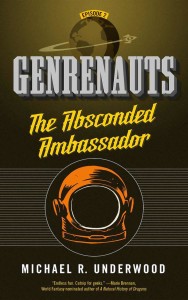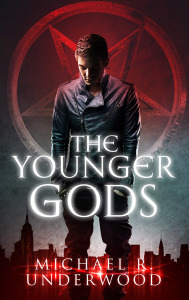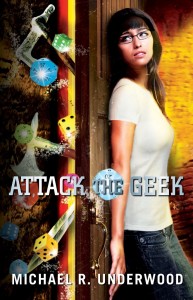Life right now is pretty Genrenauts-tastic. I’m working on final edits for Episode 3, Ep. 4 is off for edits soon, etc.
And “There Will Always be a Max,” a Genrenauts short, is coming to Tor.com on April 6th.

Which means, with the release of THE ABSCONDED AMBASSADOR very fresh in my mind, I have some things to say and people to thank, which I did largely on Twitter, but will repeat here:
The Absconded Ambassador is dedicated to Dave Robison, an OG (Original Genrenaut), for helping me develop the core premise of the series at a critical juncture, and for his ongoing contributions to the genre in fostering community and helping writers develop their voice and craft.
I lift a Neon Space Drink (TM) to my editor Lee Harris, who took a chance on the series and helped me bring this vision into the world.
I’m also very grateful to Irene Gallo, Christine Foltzer, and Peter Lutjen for creating the cover design and series style for Genrenauts, reflecting the genre love and playfulness of the series.
My Copy-Editor, Amanda Hong, kept the alien species consistent, made sure I kept the timeline clear, and in general polished the book to look better than it had been before.
Katharine Duckett has done a fantastic job spreading the word about the series and helping me get it into the hands of people far and wide. Thanks also to Mordicai Knode and Carl Engle-Laird for their assistance along the way.
I am so delighted to be a part of the Tor.com Publishing experiment, and the campaign to show that #NovellasAreTheNewNovel.
And speaking of #NovellasAreTheNewNovel, Matt Wallace has been a great supporter of the series, for which I am very grateful. Thanks, brother.
My agent Sara Megibow is the Opener of Doors, the Herald of Awesomeness, always there to help me plow throw when things get rough.
Every book I write is a love letter to the stories that have inspired me, and a suggestion of how we can move forward. As an Ex-Academic, most of my books so far have been my way of taking what I have to say about the genre and the world and putting it into story form. Never has this been more the case than in Genrenauts. I’m really excited about the characters of this series and what they have to say.
Writing Genrenauts has already helped me stretch my skills and learn to write more thoughtfully, more energetically, and more flexibly. (That ONE SECRET FOR WRITING SUCCESS everyone asks about? It’s actually lat stretches. Keep that between you and me.)
And the response so far has been very exciting. Here are some of the reviews for the series:
“This is fun…Readers will be looking forward to Leah and company’s next trip to a story world.”
–Library Journal
“It’s an entertaining enough concept, and the diverse cast of characters is a nice change of pace.”
–Publishers Weekly
“It’s storytelling as heroism, genre savviness as power. Endless fun.”
–Marie Brennan, World Fantasy Award-nominated author of A Natural History of Dragons
“A clever, exciting, and seriously fun twist on portal fantasy that sends a geeky stand-up comedian into the Wild West. Sign me up to be a Genrenaut, too!”
–Delilah S. Dawson, author of the Blud series, Hit, and Wake of Vultures, written as Lila Bowen
“My favorite new TV show of 2015 isn’t on TV, it’s in the pages of Mike Underwood’s Genrenauts. Deeply funny and creative, shrewdly insightful, and thrillingly paced, every pop culture diehard will want to keep living vicariously through the characters in this series.”
–Matt Wallace, author of the Slingers Saga and Envy of Angels.
“I have this sinking feeling that the Genrenauts series, with its raucous meta-commentary upon the stories of pop culture, is going to say important things that I might not be clever enough to catch the first time around because I’m too busy enjoying the books.”
–Howard Tayler, Hugo Award winner and creator of Schlock Mercenary
“…a rollicking exploration of western tropes, with hints of a larger conspiracy afoot. Underwood has plans for a lot more of these, and I can’t wait to read them.”
–Joel Cunningham, B&N Sci-Fi & Fantasy Blog
and for Episode 2,
“The second episode in Michael R. Underwood’s Genrenauts delivers on the promise of Episode 1, and demonstrates that his special alchemy of Leverage + The Librarians + Quantum Leap + Thursday Next (just my current guess at his secret recipe) has legs — and will hopefully go a long time.”
– Irresponsible Reader
“…it’s a heck of a lot of fun the way Galaxy Quest is: a little goofy, a little serious but not taking itself too seriously, and filled with a fondness for the source material that gives it weight without weighing down the story.”
–Samantha Holloway, New York Journal of Books
it offers a wonderfully creative premise: Fictional stories are really alternate universes in which problems bleed over into our would and cause calamities here.
–Leah Hansen, RT Reviews
In closing, I hope you’ll join Team Genrenauts and see where the story goes next.
The latest Genrenauts story is The Absconded Ambassador. Weird aliens, diplomatic wrangling, space dogfights, genre ruminations, and more:



